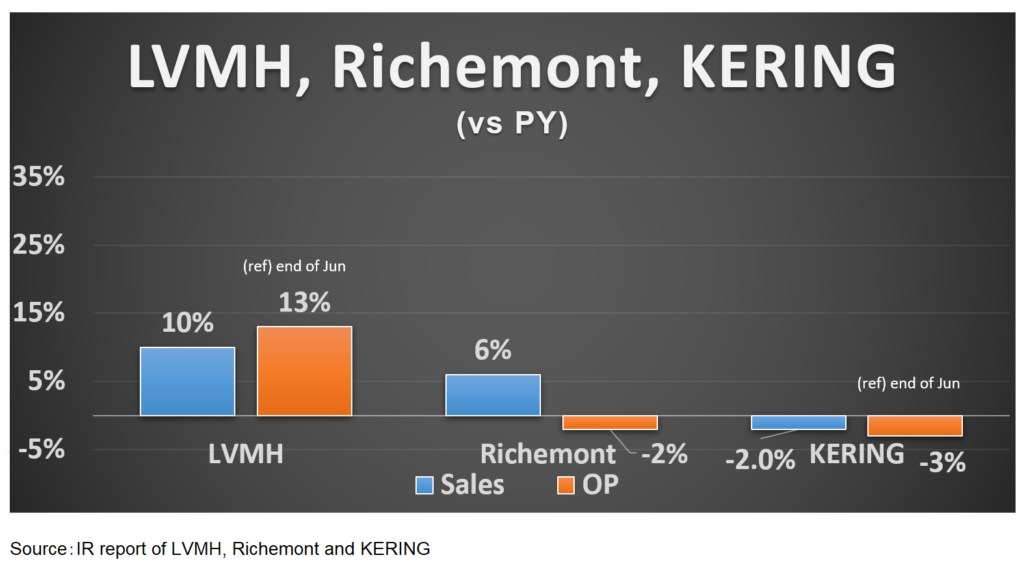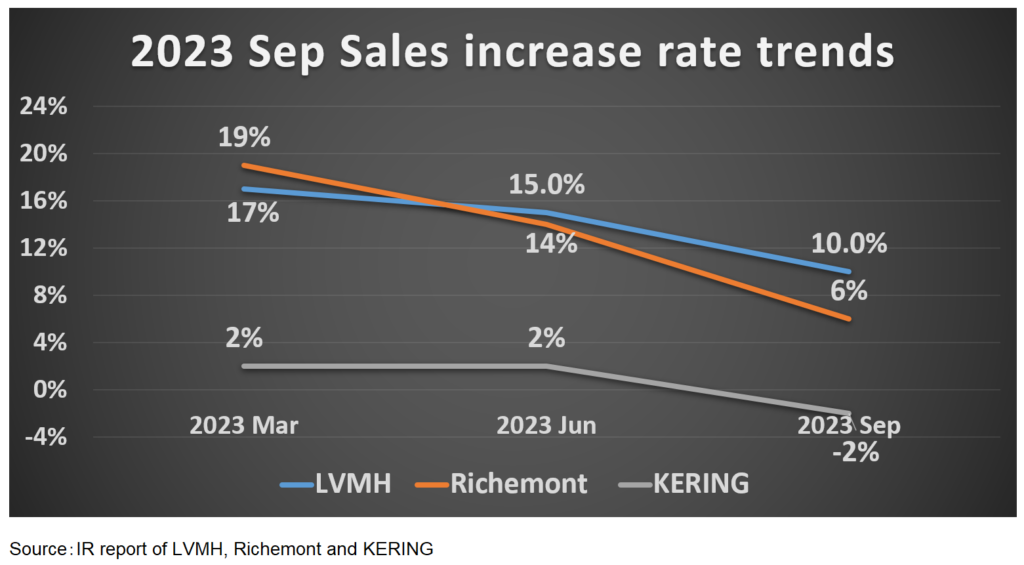2023 3Q Luxury Brand Top3 Result
Luxury Giants LVMH, Richemont, and Kering: Q3 2023 Performance Comparison
On Friday, 10 November, Richemont released its interim results, completing the lineup of Q3 earnings from the three luxury giants: LVMH, Richemont, and Kering. This article compares their recent performances and highlights key trends across the sector.
Summary of the Three Companies
The table below compares year-over-year growth in revenue and operating profit. Richemont’s results cover Q2 and include operating income, while LVMH and Kering, which reported Q3 data, did not disclose operating profit; thus, their latest available data from the end of June is referenced. One notable point: Richemont’s operating margin declined by 2% YoY.

The quarterly trend in revenue growth for each company shows a downward slope, with Kering recording a YoY decrease, highlighting a significant slowdown in its performance.

LVMH: Resilient Growth Led by Fashion and Leather
1. Revenue
LVMH posted an impressive +14% organic growth, outperforming the other two companies. The difference between this number and the graph (10%) stems from exchange rate adjustments—organic growth removes such factors.
2. By Segment
While the Wines & Spirits segment fell by 7%, largely due to declining cognac sales, fashion & leather goods surged by 16%, and perfumes & cosmetics grew by 12%. These segments continue to show strong momentum.
3. By Region
Except for the US, all major regions recorded double-digit growth. The US market remains sluggish, mirroring Q2 performance.
4. Japan
Japan stood out with a +31% revenue increase, continuing its strong showing from Q2 (+30%). As this compares to the post-border reopening period, it’s worth monitoring future growth sustainability in this market.
Richemont: Strong in Jewellery, But Signs of a Slowdown
As Richemont follows a March fiscal year, its Q2 ends in September. Although the company maintained double-digit growth, the overall pace has started to decelerate slightly.
1. Revenue
Revenue grew by 12% YoY (April–September), with organic growth maintaining healthy levels similar to LVMH.
2. By Segment
Growth was driven mainly by jewellery maisons (+10%) like Cartier and Van Cleef & Arpels, while watch brands declined by 3%. The watch division’s negative growth is concerning and warrants close observation in future quarters.
3. By Region
APAC and Japan together account for 50% of Richemont’s sales. With the US market underperforming, there is a noticeable regional concentration in Asia. Expansion strategies may be needed in Europe and North America.
4. Japan
Revenue in Japan increased by 13%, driven by strong inbound demand. As with LVMH, Japan remains a market to watch for sustained performance.
Kering: Revenue Decline Raises Concerns
Kering reported its first YoY revenue decline for FY2023, marking a turning point in its recent earnings trend.
1. Revenue
Revenue fell by 2%, contrasting with the growth seen at LVMH and Richemont. With performance deteriorating each quarter, recovery remains uncertain. However, the appointment of a new creative director offers a potential catalyst for future revival.
2. By Segment
The main reason for Kering’s decline is Gucci, its largest brand, which also saw a 2% drop. Gucci’s high weight in Kering’s portfolio means its performance has a significant impact on the group’s overall results.
3. By Region
The US market declined by 21%, a steep drop compared to peers. This underperformance is one of the most severe among the three luxury groups.
4. Japan
Japan was the only bright spot, recording a remarkable +32% YoY growth, repeating its strong performance from Q2. Without this, Kering’s results would have looked even worse. The key question now is whether Japan can continue to drive results moving forward.
Conclusion: A Mixed Bag for Luxury Leaders
While LVMH and Richemont showed steady growth, Kering’s struggles indicate that the luxury sector’s momentum may be slowing overall. With the upcoming holiday season—a crucial period for the industry—how these companies perform will significantly influence their year-end results. We’ll revisit this topic when the next round of earnings is released.
